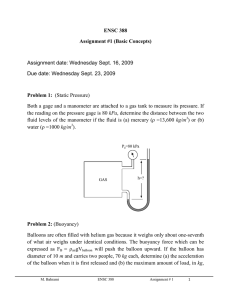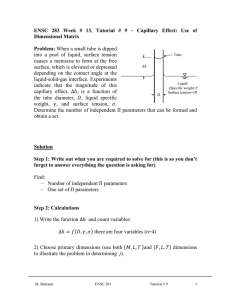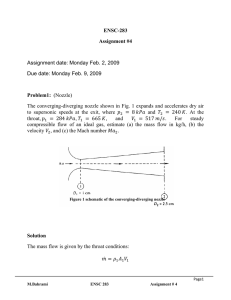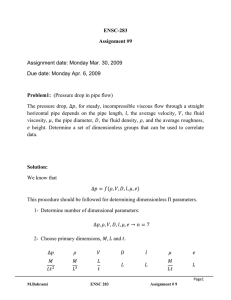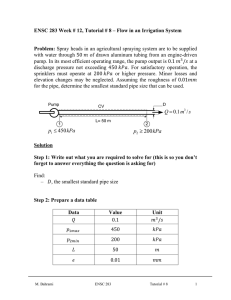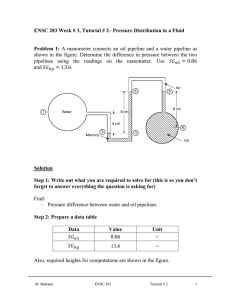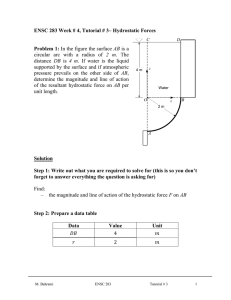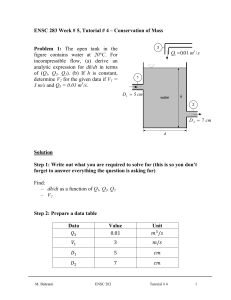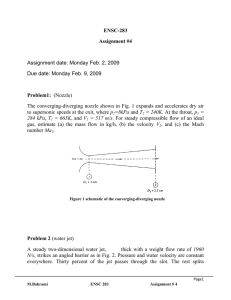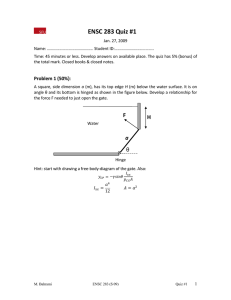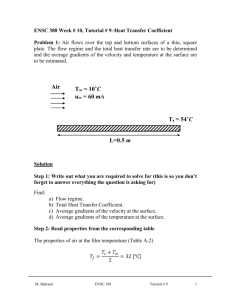Assignment1_Solutions
advertisement
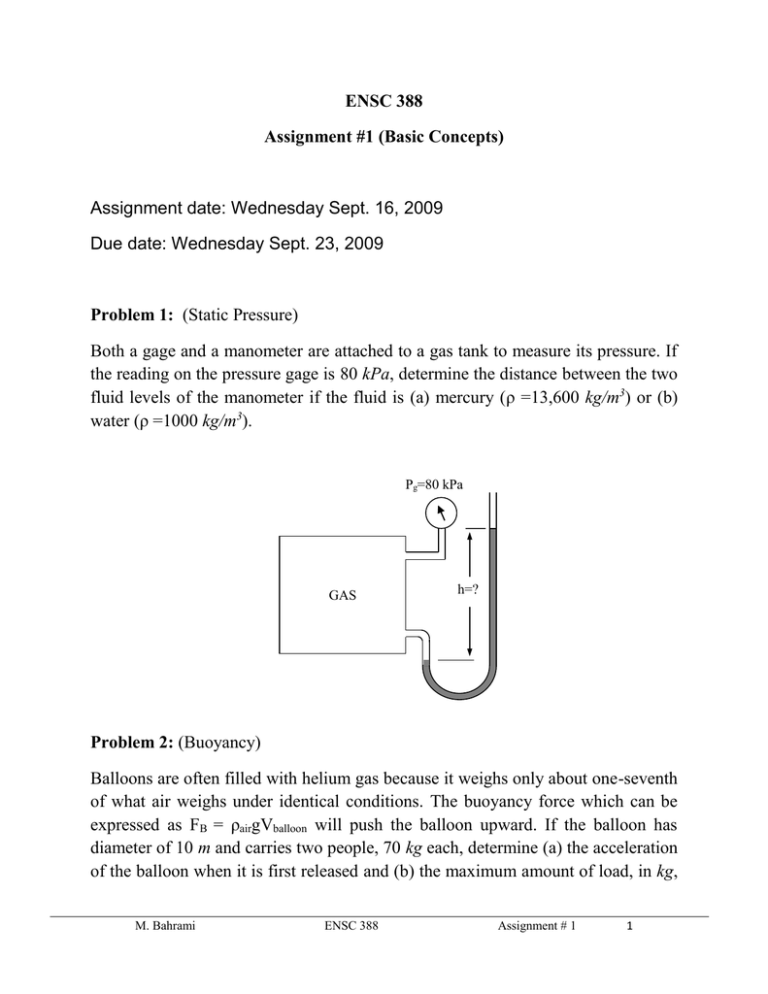
ENSC 388
Assignment #1 (Basic Concepts)
Assignment date: Wednesday Sept. 16, 2009
Due date: Wednesday Sept. 23, 2009
Problem 1: (Static Pressure)
Both a gage and a manometer are attached to a gas tank to measure its pressure. If
the reading on the pressure gage is 80 kPa, determine the distance between the two
fluid levels of the manometer if the fluid is (a) mercury (ρ =13,600 kg/m3) or (b)
water (ρ =1000 kg/m3).
Pg=80 kPa
GAS
h=?
Problem 2: (Buoyancy)
Balloons are often filled with helium gas because it weighs only about one-seventh
of what air weighs under identical conditions. The buoyancy force which can be
expressed as FB = ρairgVballoon will push the balloon upward. If the balloon has
diameter of 10 m and carries two people, 70 kg each, determine (a) the acceleration
of the balloon when it is first released and (b) the maximum amount of load, in kg,
M. Bahrami
ENSC 388
Assignment # 1
1
the balloon can carry. Assume the density of air is ρ =1.16 kg/m3, and neglect the
weight of the ropes and the cage. (Answers: 16.5 m/s2, 520.6 kg)
HELIUM
D=10 m
ρ=ρair/7
m=140 kg
Problem 3: (Hydrostatic pressure)
The lower half of a 10-m-high cylindrical container is filled with water (ρ =1000
kg/m3) and the upper half with oil that has a specific gravity of 0.85. Determine the
pressure difference between the top and bottom of the cylinder. (Answer: 90.7
kPa)
OIL
ρs=0.85
h=10 m
WATER
ρ =1000 kg/m3
M. Bahrami
ENSC 388
Assignment # 1
2
Pg=80kPa
Patm
Problem 1:
2
Pg =80 kPa
Find h if:
h=?
GAS
3
a) Fluid is mercury (ρHg=13,600 kg/m )
b) Fluid is mercury (ρH2O=1000 kg/m3)
1
- Assumption:
The pressure is uniform in the tank, thus we can determine the pressure at the gage
port.
- Analysis
Starting with 𝑃𝑔 (gas pressure) and moving along the tube from point (1) by
adding (as we go down) or subtracting (as we go up), the ρgh term(s) until we
reach point (2), therefore;
𝑃𝑔 − 𝜌𝑔ℎ = 𝑃2
Since tube at point (2) is open to atmosphere, 𝑃2 = 𝑝𝑎𝑡𝑚 .
𝑃𝑔 − 𝑃2 = 𝜌𝑔ℎ
Pgage (What we read on the pressure gage)
𝑘𝑔⁄
] × 9.81 [𝑚⁄ 2 ] ℎ𝐻2 𝑂
𝑚3
𝑠
= 8.155[𝑚]
𝐻2 𝑂 → 80 × 103 [𝑃𝑎] = 1000 [
⟹ ℎ𝐻2 𝑂
80 kPa =ρgh
𝑘𝑔⁄
] × 9.81 [𝑚⁄ 2 ] ℎ𝐻𝑔
𝑚3
𝑠
= 0.599[𝑚]
𝐻𝑔 → 80 × 103 [𝑃𝑎] = 13,600 [
⟹ ℎ𝐻2 𝑂
{
FB
Problem 2:
D
M. Bahrami
ENSC 388
Assignment # 1
3
mhe
D=10 m
ρHe= ρair/7 and ρair =1.16 kg/m3
mpeople=140 kg
a
Assumption:
mpeople
The wight of the ropes and cage is neglected.
W
(Free body diagram)
Analysis:
Starting with free body diagram. We also know that te buoyancy force is:
𝐹𝐵 = 𝜌𝑎𝑖𝑟 𝑔𝑉𝑏𝑎𝑙𝑙𝑜𝑜𝑛
𝑊 = 𝑚𝑡𝑜𝑡𝑎𝑙 𝑔
𝑚𝑡𝑜𝑡𝑎𝑙 = 𝑚𝑝𝑒𝑜𝑝𝑙𝑒 + 𝑚𝐻𝑒
𝑚𝐻𝑒 = 𝜌𝐻𝑒 𝑉𝑏𝑎𝑙𝑙𝑜𝑜𝑛
4 3
𝑉𝑏𝑎𝑙𝑙𝑜𝑜𝑛 = 𝜋𝑅𝑏𝑎𝑙𝑙𝑜𝑜𝑛
3
4
𝑉𝑏𝑎𝑙𝑙𝑜𝑜𝑛 = 𝜋(5[𝑚])3 = 523.59[𝑚3 ]
3
𝑚𝐻𝑒 =
1
𝑘𝑔
× 1.16 [ ⁄ 3 ] × 523.59[𝑚3 ] = 86.77
𝑚
7
𝑚𝑡𝑜𝑡𝑎𝑙 = 𝑚𝐻𝑒 + 𝑚𝑝𝑒𝑜𝑝𝑙𝑒 = 86.77[𝑘𝑔] + 140[𝑘𝑔] = 226.77[𝑘𝑔]
Newton law:
∑ 𝐹 = 𝑚𝑡𝑜𝑡𝑎𝑙 × 𝑎
Therefore:
M. Bahrami
ENSC 388
Assignment # 1
4
𝐹𝐵 − 𝑊 = 𝑚𝑡𝑜𝑡𝑎𝑙 × 𝑎
(1)
𝜌𝑎𝑖𝑟 𝑔𝑉𝑏𝑎𝑙𝑙𝑜𝑜𝑛 − 𝑚𝑡𝑜𝑡𝑎𝑙 𝑔 = 𝑚𝑡𝑜𝑡𝑎𝑙 𝑎
So,
𝑎=
𝜌𝑎𝑖𝑟 𝑉𝑏𝑎𝑙𝑙𝑜𝑜𝑛 −𝑚𝑡𝑜𝑡𝑎𝑙
𝑚𝑡𝑜𝑡𝑎𝑙
𝑔
(2)
Substituting values in Eq. (2),
𝑎=
1.16 [
𝑘𝑔⁄
] × 523.59[𝑚3 ] − 226.77[𝑘𝑔]
𝑚3
× 9.81 [𝑚⁄ 2 ]
𝑠
226.77[𝑘𝑔]
𝑎 = 16.46 [𝑚⁄ 2 ]
𝑠
The maximum amount of load that the balloon can carry can be calculated from;
∑𝐹 = 0
Using Eq. (1),
𝐹𝐵 = 𝑊
𝜌𝑎𝑖𝑟 𝑔𝑉𝑏𝑎𝑙𝑙𝑜𝑜𝑛 = 𝑚𝑚𝑎𝑥 𝑔
𝑚𝑚𝑎𝑥 = 𝜌𝑎𝑖𝑟 𝑉𝑏𝑎𝑙𝑙𝑜𝑜𝑛 = 1.16 [
𝑘𝑔⁄
] × 523.59[𝑚3 ] = 607.304
𝑚3
This mass is including the mass of helium gas in the balloon. To calculate
maximum load, mass of helium must subtracted from the maximum mass so,
𝑚𝑚𝑎𝑥,𝐿𝑜𝑎𝑑 = 𝑚𝑚𝑎𝑥 − 𝑚ℎ𝑒 = 607.304[𝑘𝑔] − 86.77[𝑘𝑔] = 520.6[𝑘𝑔]
1
Problem 3:
𝜌𝑜𝑖𝑙
⁄𝜌
𝐻2 𝑜 = 0.85
OIL
h=5 m
Analysis:
M. Bahrami
ENSC 388
Assignment # 1
5
h=5 m
Starting with point (1) and adding terms gh as
WATER
we go down,
𝑃1 + 𝜌𝑜𝑖𝑙 𝑔ℎ𝑜𝑖𝑙 + 𝜌𝐻2 𝑜 𝑔ℎ𝐻2 𝑜 = 𝑃2
𝜌𝑜𝑖𝑙 𝑔ℎ𝑜𝑖𝑙 + 𝜌𝐻2 𝑜 𝑔ℎ𝐻2 𝑜 = 𝑃2 − 𝑃1
2
𝜌
𝑃2 − 𝑃1 = ( 𝑜𝑖𝑙⁄𝜌𝐻 𝑜 ℎ𝑜𝑖𝑙 + ℎ𝐻2 𝑜 ) 𝜌𝐻2 𝑜 𝑔
2
Substituting values,
𝜌𝐻2 𝑜 = 1000 [
𝑘𝑔⁄
]
𝑚3
𝑃2 − 𝑃1 = (0.85[−] × 5[𝑚] + 5[𝑚])1000 [
𝑘𝑔⁄
] × 9.81 [𝑚⁄ 2 ]
𝑚3
𝑠
= 90.742[𝑘𝑃𝑎]
Notes (1): Always substitute the numerical value at the last step.
Note (2): Write all the dimensions in your solution; check both sides of
relationships for unit and dimension homogeneity.
M. Bahrami
ENSC 388
Assignment # 1
6
